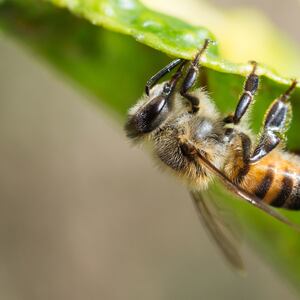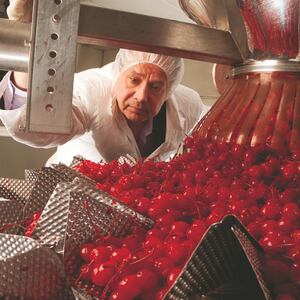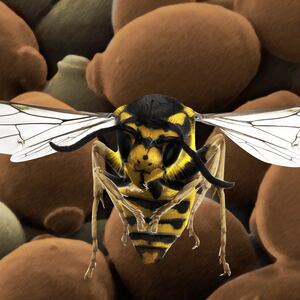Jerry Bromenshenk has been at the forefront of the bee colony collapse. He’s seen harrowing scenes, some that he will never forget.
“I have seen stockpile yards of 10,000 colonies, ready to go into almonds in California, lose anywhere from 50 to 90 percent of the colonies in less than two weeks,” the bee expert from the University of Montana in Missoula said. “It was like a wave running through the yard, from one end to the other. In all cases, the bees just disappear from the hives.”
But Bromenshenk believes there’s a solution that might finally give apiarists a reprieve and end the horror once and for all: artificial intelligence. New A.I. tools might finally give apiarists a chance to get to the bottom of what’s ailing beehives around the world—and more importantly, give them a chance to proactively mitigate, and prevent entire colonies from disappearing almost overnight.
Bees might seem like a buzzing nuisance, but they’re a vital part of life on this planet. One-third of every mouthful of food is tied to successful pollination, much of which is carried out by pollinators like bees.
But this precious pollination cycle is in danger. Colony Collapse Disorder (CCD) was formally identified in a 2006 report detailing the sudden and unexcited loss of bees. CCD strikes when seemingly thriving bee colonies with plenty of food stores and artificial hive frames on farms with eggs, larvae, and pupae empty themselves of adult bees with a matter of days, leaving behind—at best—a queen and a handful of bees in the hive, with no evidence of dead and dying bees on the bottom boards or in front of the hives.
The list of possible culprits varies: microbial and viral diseases; invasive pests; environmental stressors brought on by climate change; poor nutrition and the toxic effects of pesticides; and modern crop hybrids that are unattractive or too low in nectar, among others. Some of these factors are thought to interact and exacerbate CCD.
“To date, we still do not fully understand CCD,” Bromenshenk told The Daily Beast.
So Bromenshenk paired up with a friend, Robert Seccomb, to develop an A.I.-powered app called Bee Health Guru that could study bee colonies, keep beekeepers apprised of hive health, and identify the sorts of nuanced factors that portend a collapse event—giving beekeepers a chance to remedy the situation and save their hives.
“A human can do everything that our A.I. system can do; however, it would take an exceptional human,” Seccomb told The Daily Beast. “Machine learning excels in tirelessly processing large amounts of complex data in a short time.
“In tackling the CCD problem, we cannot expect A.I. to be the magic bullet for a solution,” Seccomb said. “However, it may find those patterns we humans could miss, especially when faced with large data sets and complex sets of variables. A.I. is supremely qualified for this flood of data in ways humans have a hard time keeping up.”
One of those complex reservoirs of data is in the sound a swarm makes—and it’s the core application behind Bee Health Guru, which formally launched on May 1. Bromenshenk and Seccomb have taught the app’s A.I. how to track the sound waves and anticipate future changes to the swarm, days or even weeks before that behavior actually manifests. In tracking those changes with other variables, a beekeeper might suddenly have a sense of how to plan for those swarm changes ahead of time, or outright nip those changes in the bud, and stabilize the beehive. These changes could be as big as the sudden loss of a queen, or as subtle as a bacterial infection that’s slowly spreading through the hive.
To that end, A.I. is not just a faster alert system—it’s also predictive of what might happen without intervention.
Other groups are also looking into measuring sound, as well as collecting data on other metrics that can reveal changes to hive health, including brood temperatures, ambient temperatures, hive weight, humidity, and swarm behaviors.
One of these groups is headed by multinational tech company Oracle. The company has collaborated with the World Bee Project and the University of Reading in the U.K. to produce an apiary monitoring system comprising six smart sensors that collect a slew of different data, including feet and wing movement in worker bees, the weight of the hive’s honey, humidity, ambient temperatures, local weather and pollution levels, and—like Bee Health Guru—swarm sound. Oracle deployed these systems last fall, in hives across the U.K., Australia, and Israel.
Bee Health Guru can provide personalized data to individual beekeepers, but A.I. also opens up avenues in sharing and scaling data in order to highlight local, regional or global trends that could lead to CCD—and this is where Oracle and the World Bee Project really hope to make an impact.
John Abel, Oracle’s vice president for cloud and innovation in the U.K., Ireland and Israel, is bullish on the way these programs, when connected, can collect different layers of data and pinpoint patterns of beehive health that emerge. The A.I. isn’t just effective in highlighting small changes in, say, swarm sound—it can go the distance in showing how changes in swarm sound at one end of a continent may be a harbinger of hive problems at the other. It could use data from Portugal to explain what’s happening in Sweden.
“The great thing about the bees is that they give you an indication of how good you make a sustainable landscape,” Abel said. “It gives you a good insight into how good your ecosystem is.”
It’s really just a matter of making these tools more readily available to apiarists around the world. Oracle is working to launch more of its systems around the world. Bee Health Guru formally launched on May 1, along with a Kickstarter campaign aimed at helping the company scale up.
And there are many other players in this space looking to make an impact. While the footprint of these tools is small in comparison to the world’s 80 million hives, it’s growing. It has to—our way of life depends on it.









